mobile View, to the German Version tap the flag


- Lower Austria (Niederösterreich)
- Federal Country of the Republic of Austria
- former Austrian crown land: Archduchy of Austria below the Enns
• Flags
• Meaning/Origin of the Flag
• Coat of Arms
• Meaning/Origin of the Coat of Arms
• Map of the federal countries of Austria
• Map of the former crown lands of Austria-Hungary (to 1918)
• Numbers and Facts
• History
• Origin of the Country's Name
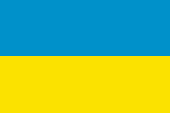
Flag of the country (Colours of the country),
ratio = 2:3,
Source, by: Wikipedia (D),
Colour, by: Dr. Peter Diem www.peter-diem.at



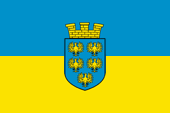
Official flag,
ratio = 2:3,
Source, by: Wikipedia (D),
Colour, by: Dr. Peter Diem www.peter-diem.at







The flag of Lower Austria shows two stripes in blue and gold and was officially and lastly confirmed on the 9th of August in 1954. The colours of the flag are derived from the colours of the coat of arms. The flag itself was already in use in the 19th century.
In the time of the monarchy, the country had – like all the other crown lands of the Austrian crown – its own colours (Landesfarben), which were used amongst others on horizontally two- or three-striped flags. The colours (Landesfarben) were very often taken from the respective coat of arms of the country or were supplemented by another colour, which not appears in the coat of arms, or they went back to older models of the coat of arms (e.g. Carniola). Officially, the colours had never been regulated or stipulated, so that their sequence varied in practice or even the colors deviated. The Austrian heraldist Hugo Gerard Ströhl (1851–1919) was probably the first to take care of it and asked for the colors (Landesfarben) on the flags at the respective state authorities around 1890 and compiled them. For Austria below the Enns (Lower Austria), blue and yellow were ascertained as the country's colors of the crown land.
Austria joined the German Empire in 1938 as one country. The federal structures played no role, they were completely replaced by the NSDAP districts (NS-Gau), the countries were abolished. From now on, offices and authorities had to use the empire's official flag. The corresponding national colors may still have exist, but not in the form of flags. They may have been used sporadically on SA uniforms or in some ranks of the Hitler Youth in the chest cord.
The flags of the federal countries of Austria are used with or without the coat of arms. For official use, however, they always show it. The general population is permitted to use this format as well.
There do not seem to be any legal regulations for the colours of the flags of the Austrian federal states; since they are apparently not defined, they are reproduced in practice within a usual standard range. However, the Austrian publicist and media scientist Dr. Peter Diem gives recommendations for the reproduction of the colours: For Lower Austria, a bright blue, most likely corresponding to Pantone Hexachrome Cyan, and yellow as 100% Y.
Source: Dr. Peter Diem austria-forum.org,
Wikipedia (D),
Flaggen Enzyklopädie,
Volker Preuß,
Österreichisch-Ungarische Wappenrolle


since 1920,
Coat of arms of Lower Austria
Source, by: Wikipedia (D)
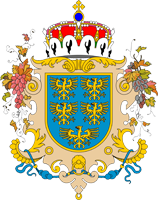
ca.1890–1918,
Coat of arms of the Archduchy of Austria below the Enns
Source, by: Ströhl, Wappenrolle Österreich-Ungarns, 1890, via Wikipedia (D)

The today's coat of arms of Lower Austria was created in 1920 and shows an single-coloured blue shield with five golden eagles in it. Above the shield a mural crown. It symbolizes the in 1918 established power of the bourgeois. As an Habsburg crown land the coat of arms showed above the Austrian ducal crown. The Austrian heraldist Hugo Gerard Ströhl surrounded the coat of arms ca. 1890, in its last known version, with for the country typical flora. For the Archduchy of Austria below the Enns (Lower Austria) this had been vines, to emphasize the importance of the country as a wine-growing region.
Source: Wikipedia (D),
Flaggen Enzyklopädie,
Österreichisch-Ungarische Wappenrolle

The federal countries of Austria:
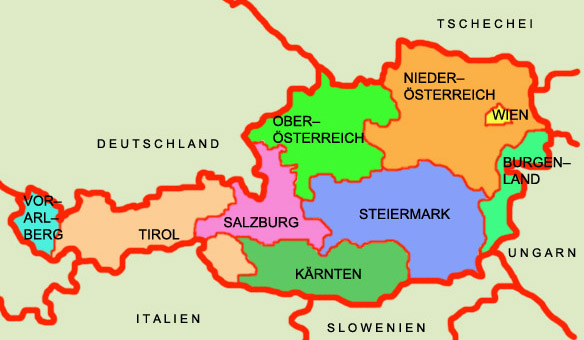
Source: Volker Preuß
• Burgenland
• Carinthia (Kärnten)
• Lower Austria (Niederösterreich)
• Upper Austria (Oberösterreich)
• Salzburg
• Styria (Steiermark)
• Tyrol (Tirol)
• Vorarlberg
• Vienna (Wien)

Map ca. 1910:
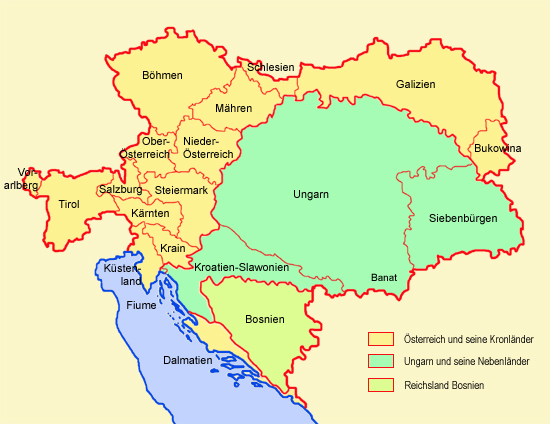
Source: Volker Preuß

Area: 7.408 square miles
Inhabitants: 1.677.500 (2019)
Density of Population: 226 inh./sq.mi.
Capital: St. Pölten (to 1986 Vienna), 55.000 inh. (2019)
official Language: German
Currency: 1 Euro = 100 Cent
Time Zone: MEZ
Source: Wikipedia (D)

antiquity · in the today’s Lower Austria settle Raetians and Celts
since 14 B.C. · Roman conquest of the territories southern the Danube River, establishment of the Province of Noricum
166–168 · invasions of the Teutonic tribes of the Marcomans, Quades and Langobards
233 · invasions of the Quades
254 · invasions of the Marcomans
409–452 · invasions of the Huns
476 · dismissal of the last Roman emperor Romulus Augustulus, end of the (West)Roman Empire, the today's Lower Austria belongs until 553 to the Empires of the Goth and the Langobardes, settlement by Bayuvares
788 · conquest by the Frankish Empire of the Carolingians
795 · establishment of the "Awarian Mark"
843/870/880 · at the division of the Frankish Empire comes the Awarian Mark to the East Frankish Empire (later named German Empire)
900–955 · invasions of the Hungarians
955 · Battle on the Lech-Field, victory over the Hungarians, formation of the Bavarian Ostmark, in 996 for the first time named "Ostarrîchi"
976 · establishment of the Duchy of Carinthia, of the Margraviate of Ostmark (Austria), Styria and Carniola, the Counties of Tyrol and Goerz, the Arch Diocese of Salzburg, the Diocese of Trient and the Patriarchate of Aquileia
976 · the House of Babenberg becomes the Margraves of the Ostmark
1156 · Austria (Oesterreich/Ostmark) becomes a duchy
1246 · vanish of the Babenbergs, Austria and Steiermark come to the Bohemian Premyslides
1273 · Rudolf of Habsburg becomes German King
1278 · Rudolf of Habsburg beats the Bohemian Premyslides and acquires Austria and Steiermark
1458 · administrative partition of the Duchy of Austria in "Austria below der Enns" (Lower Austria) and "Austria above the Enns" (Upper Austria), the status as a consistent Duchy of Austria remains untouched
1683 · repulse of the Turks at Vienna
1848/1849 · revolution, new constitution: the titular hereditary territories of the Habsburgs in the Austrian Empire become converted to crown lands with their own Landtag (parliament), Lower Austria and Upper Austria become each a crown land of the Empire of Austria
12th of November 1918 · proclamation of German Austria to the Republic of Austria, Lower Austria and Upper Austria become Austrian federal countries
13th of March 1938 · Annexation of Austria to the German Empire, the NS-Gau "Niederdonau" (Lower Danube) takes the place of Lower Austria
27th of April 1945 · proclamation of the Republic of Austria "Second Republic", Lower Austria and Upper Austria become again Austrian federal countries, but Lower Austria stays occupied by Soviet troops until 1955
1955 · withdrawal of the occupation troops
1986 · the capital of the country becomes moved from Vienna to St. Poelten
Source: Atlas zur Geschichte,
Wikipedia (D),
World Statesmen,
RetroBib Retrobibliothek,
Discovery '97,
Volker Preuß

"Lower Austria" was originally calles "Austria below der Enns" what points out to the Enns River. It is a part of the frontier between Lower Austria and Upper Austria (Austria above the Enns). The modern designation for the both parts of the Arch-Duchy of Austria should been arised in the beginning of the 20th century.
Source: Handbuch der geographischen Namen,
Atlas der wahren Namen

Further Austria pages (historical flags and coats of arms):
• Empire of the Austrian Habsburgs (to 1804)
• Empire of Austria (1814–1867)
• Austria-Hungary (1867–1918)
• Republic of Austria (since 1918)

![]()












